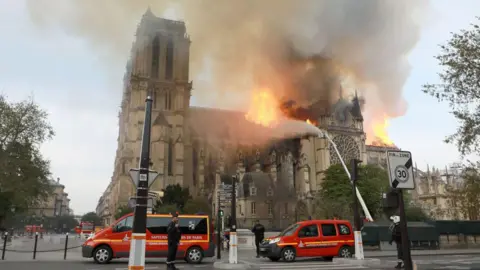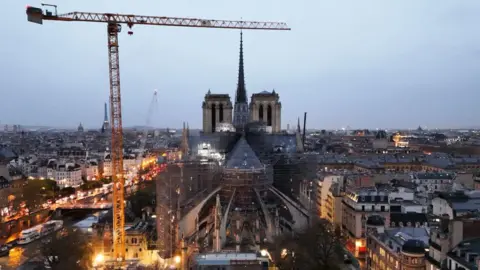Paris’s Gothic jewel will reopen five years after the fire

 Getty Images
Getty ImagesThe world is getting a glimpse inside the gleaming new Notre-Dame as French President Emmanuel Macron conducts a televised tour to mark the cathedral’s reopening.
Five and a half years after the devastating fire of 2019, the Gothic gem of Paris has been rescued, repaired and renovated – offering visitors what promises to be an incredible experience.
The president – accompanied by his wife Brigitte and the Archbishop of Paris Laurent Ulrich – begins a program of events that will conclude with the official “entry” into the church on December 7 and the first Catholic Mass the following day.
After being shown the highlights of the building’s €700 million (£582m) renovation – including huge roof beams replacing a medieval frame that was gutted in a fire – he will deliver a speech of thanks to around 1,300 artists and women gathered in the nave.
The renovated interior of Notre-Dame has been kept a closely guarded secret – with only a handful of photographs released over the years marking the progress of the renovation work.
But people who have been inside recently say that this experience is surprising, the cathedral has been lifted up with a new clarity and light that shows a great contrast with the darkness that was filled before.
 Getty Images
Getty Images“The word that would best capture the day is ‘glamour’,” said an Elysée insider close to the restoration.
“People will see the splendor of the carved stone, [which is] an unmistakable whiteness that had not been seen in the church for perhaps centuries.”
On the night of April 15, 2019, viewers around the world watched in amazement as live footage was broadcast of orange flames spreading across the cathedral’s roofand then – at the peak of the blaze – the 19th Century spire crashes to the ground.
The cathedral – whose structure was already a cause for concern before the inferno – was undergoing external repairs at the time. Among the theories about the cause of the fire are a cigarette left by an employee, or an electrical fault.
About 600 firefighters battled the flames for 15 hours.
At one point, it was feared that the eight bells in the north tower were in danger of falling, which would have brought down the tower itself, and possibly many of the walls of the cathedral.
Eventually the building was saved.
Destroyed were the spire, the wooden roof beams (known as the “forest”), and the stone surround in the center of the transept and part of the nave.
There was also a lot of damage due to the fall of wood and stones, and water from the firecrackers.
Thankfully what was saved made a very long list – including all the stained glass windows, most of the sculptures and artwork, and the holy relic known as the Crown of Thorns. The organ – the second largest in France – was badly affected by dust and smoke, but it is being repaired.
Cathedral priests also celebrate certain “miracles” – miraculous survivors.
This includes a 14th Century statue in the choir known as the Virgin of the Pillar, which narrowly avoided being crushed by falling rocks.
Sixteen large bronze statues of the Apostles and Evangelists, which surrounded the ship, were taken down for repairs four days before the fire started.
After surveying the damage the next day, Macron made what to many at the time seemed like an unlikely promise: that Notre-Dame would be reopened to visitors within five years.
A public organization to manage the work was established by law, and the request for funds brought a prompt response. A total of 846 million euros were raised, mostly from big donors but also from hundreds of thousands of small donors.
Responsibility for this task was given to Jean-Louis Georgelin, a no-nonsense army general who shared Macron’s impatience with committees and the establishment of “heritage”.
“They are used to dealing with frigates. This is an aircraft carrier,” he said.
Georgelin is given full credit for the undoubted success of the project, but he died in an accident in the Pyrenees in August 2023 and was replaced by Philippe Jost.
An estimated 2,000 masons, carpenters, restorers, roofers, designers, artists, sculptors and engineers work on the project – providing a major boost to French arts and crafts.
Many trades – such as stone carving – have seen a huge increase in apprentices due to the publicity.
“[The Notre Dame project] it was the equivalent of the World’s Fair, in the way it was an exhibition of our art. It’s the best shop window for the whole world,” said Pascal Payen-Appenzeller, whose organization promotes traditional building skills.
The first task of the project was to make the area safe, then dismantle a large array of steel scaffolding that previously surrounded the peg but was melted by the fire and covered with stones.
 Getty Images
Getty ImagesAt first it was necessary to make a decision about the nature of the renovation: whether to faithfully rebuild the ancient building and the neo-Gothic changes of the 19th century by the architect Eugène Viollet-le-Duc, or to use the opportunity to mark the building with the building. modern imprint.
The appeal for new designs produced some unusual ideas, including a glass roof, a green “eco-roof”, a giant flame instead of a spire, and a vertical laser-engraved spire that shoots into space.
In the face of opposition from experts and the public, everything was abandoned and the reconstruction is very true to the original – although with some concessions to modern materials and safety requirements. Roof planks, for example, are now protected by sprinklers and insulation.
The only remaining point of contention is over Macron’s desire for a contemporary design of glass windows in the six-sided rooms. Artists have submitted entries for the competition, but there is strong opposition from many in the French art world.
Macron tried to make the renewal of Notre-Dame a theme and symbol.
He was closely involved in this work, and visited the cathedral several times.
At a time when his political fortunes are at an all-time low – following the debacle of July’s parliamentary election – the reopening is a much-needed morale boost.
Some said he was stealing credit for organizing Friday’s event – officially to celebrate the end of the program – a week before the church officially reopened. It means that the first, long-awaited interior photos will definitely focus on him.
In response the Elysée officials point out that the cathedral – like all religious buildings in France under the law of 1905 – belongs to the state, the Catholic Church “used the user” of it; and that without Macron’s prompt encouragement, the work would not have been completed so quickly.
“Five years ago, everyone thought that the president’s promise would be difficult to keep,” said an Elysée insider.
“Today we have proof that it was not only possible – but that it was in the heart what everyone wanted so passionately.
“That’s what people will see [in the new Notre Dame] the splendor and power of democracy – in Française.”
Source link





